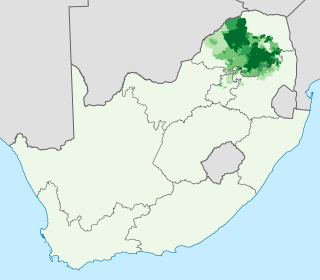
Sepedi, formerly known by as Sesotho sa Lebowa, is a Sotho-Tswana language group spoken in the northeastern provinces of South Africa. It is commonly referred to in its standardized form as Pedi or Sepedi and holds the status of an official language in South Africa.

Tswana, also known by its native name Setswana, and previously spelled Sechuana in English, is a Bantu language spoken in Southern Africa by about 8.2 million people. It belongs to the Bantu language family within the Sotho-Tswana branch of Zone S (S.30), and is closely related to the Northern Sotho and Southern Sotho languages, as well as the Kgalagadi language and the Lozi language.
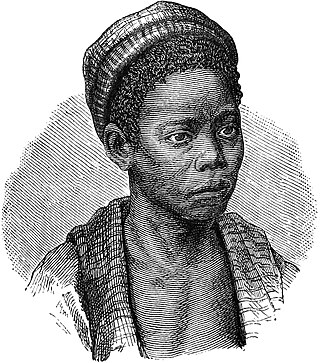
The Tswana are a bantu ethnic group native to Southern Africa. Ethnic Tswana made up approximately 85% of the population of Botswana in 2011.
SothoSesotho, also known as Southern Sotho or Sesotho sa Borwa is a Southern Bantu language of the Sotho–Tswana ("S.30") group, spoken in Lesotho, and South Africa where it is an official language;
The Bakoena or Bakwena are a large Sotho-Tswana clan in Southern Africa of the southern Bantu group. They can be found in different parts of southern Africa such as Lesotho, Botswana, South Africa and Eswatini. "Koena" ("Kwena") is a Sotho/Tswana/Sepedi word meaning "crocodile", the crocodile is also their totem (seboko).
The term Batlôkwa refers to several Kgatla communities that reside in Lesotho and South Africa.
The Sotho-Tswana languages are a group of closely related Bantu languages spoken in Southern Africa. The Sotho-Tswana group corresponds to the S.30 label in Guthrie's 1967–71 classification of languages in the Bantu family.
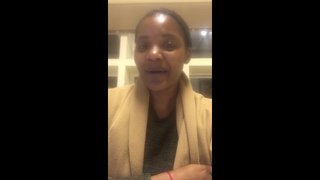
Lozi, also known as siLozi and Rozi, is a Bantu language of the Niger–Congo language family within the Sotho–Tswana branch of Zone S (S.30), that is spoken by the Lozi people, primarily in southwestern Zambia and in surrounding countries. This language is most closely related to Northern Sotho, Tswana (Setswana), Kgalagari (SheKgalagari) and Sotho. Lozi, sometimes written as Rotse, and its dialects are spoken and understood by approximately six per cent of the population of Zambia. Silozi is the endonym as defined by the United Nations. Lozi is the exonym.

Botshabelo, meaning "a place of refuge", is a large township set up in 1979 by the then apartheid government. It is located east of Bloemfontein in the present-day Free State province of South Africa. Botshabelo is now the largest township in Free State.

The Magaliesberg of northern South Africa, is a modest but well-defined mountain range composed mainly of quartzites. It rises at a point south of the Pilanesberg to form a curved prominence that intersects suburban Pretoria before it peters out some 50 km (31 mi) to the east, just south of Bronkhorstspruit. The highest point of the Magaliesberg is reached at Nooitgedacht, about 1,852 metres (6,076 ft) above sea level. A cableway reaching to the top of the mountain range is located at Hartbeespoort Dam, providing sweeping views of the Magaliesberg and surrounding area.
Soshanguve is a township situated about 30 km north of Pretoria, Gauteng, South Africa, just east of Mabopane. The name Soshanguve is an acronym for Sotho, Shangaan, Nguni and Venda, thus showing the multi-ethnic composition of the population. The major African languages of South Africa are heard in Soshanguve.

Besides referring to the language of the dominant people groups in Botswana, Setswana is the adjective used to describe the rich cultural traditions of the Batswana - whether construed as members of the Setswana ethnic groups or of all citizens of Botswana. the Batswana believe in the rich culture of Botho-Ubuntu, ‘‘People are not individuals, living in a state of independence, but part of a community, living in relationships and interdependence.’ Batswana believe in working together and in being united.

The Sotho-Tswana, also known as the Sotho or Basotho, although the term is now closely associated with the Southern Sotho peoples are a meta-ethnicity of Southern Africa. They are a large and diverse group of people who speak Sotho-Tswana languages. The group is predominantly found in Botswana, Lesotho, South Africa, and the western part of Zambia. Smaller groups can also be found in Namibia and Zimbabwe.
The phonology of Sesotho and those of the other Sotho–Tswana languages are radically different from those of "older" or more "stereotypical" Bantu languages. Modern Sesotho in particular has very mixed origins inheriting many words and idioms from non-Sotho–Tswana languages.
Phokeng is a town in Rustenburg of the North West province of South Africa. It is the capital of the Royal Bafokeng Nation. Historically, it was known as Magatostad among white South Africans.
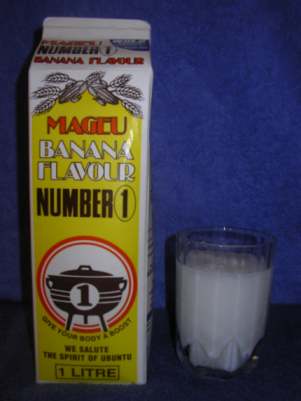
Mageu, Mahewu, Mahleu, Magau (xau-Namibia), Madleke, maHewu, amaRhewu or amaHewu is a traditional Southern African non-alcoholic drink among many of the Chewa/Nyanja, Shona, Ndebele, Nama Khoikhoi and Damara people, Sotho people, Tswana people and Nguni people made from fermented mealie pap. Home production is still widely practised, but the drink is also available at many supermarkets, being produced at factories. Its taste is derived predominantly from the lactic acid that is produced during fermentation, but commercial mageu is often flavoured and sweetened, much in the way commercially-available yogurt is. Similar beverages are also made in other parts of Africa.
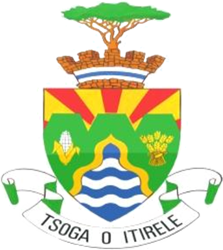
Moretele Municipality is a local municipality within the Bojanala Platinum District Municipality, in the North West province of South Africa. As of 2011, its population was approximately 180,000, a majority of whom speak Setswana as a first language.

The population of Botswana is divided into the main ethnic groups of Tswana people (73%), Kalanga people (18%), and Basarwa (2%). The remaining 7% consist of other peoples, including some speaking the Kgalagadi language, and 1% of non-African people.

Tokologo Municipality is a local municipality within the Lejweleputswa District Municipality, in the Free State province of South Africa. Tokologo is a Setswana word meaning "freedom".
Pretoria Taal, or Pretoria Sotho, is the urban lingua franca of Pretoria and the Tshwane metropolitan area in South Africa. It is a combination of Sepedi-Tswana and influences from Tsotsitaal, Afrikaans and other Bantu languages of the region. It is spoken by most black residents of all ages and levels of education in Tshwane. Though it is most commonly used in informal situations, it is also used in schools and at political events in which people have different language backgrounds. Standard Setswana and Northern Sotho are not commonly used in schools except in SeTswana and Northern Sotho lessons. Pretoria Taal is mutually intelligible with SeTswana and Northern Sotho.









